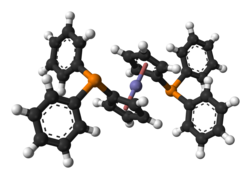1,1'-Bis(diphenylphosphino)ferrocene

| |

| |
| Names | |
|---|---|
| Preferred IUPAC name
(Ferrocene-1,1′-diyl)bis(diphenylphosphane) | |
| Other names
1,1′-Bis(diphenylphosphino)ferrocene, 1,1′-ferrocenediylbis(diphenylphosphine), Dppf, 1,1′-ferrocenebis(diphenylphosphine), 1,1′-bis(diphenylphosphanyl)ferrocene
| |
| Identifiers | |
3D model (
JSmol ) |
|
| ChEBI | |
| ChemSpider | |
ECHA InfoCard
|
100.167.773 |
| EC Number |
|
| 24075 | |
PubChem CID
|
|
| UNII | |
CompTox Dashboard (EPA)
|
|
| |
| |
| Properties | |
| C34H28FeP2 | |
| Molar mass | 554.391 |
| Melting point | 181 to 183 °C (358 to 361 °F; 454 to 456 K) |
| Hazards | |
| Occupational safety and health (OHS/OSH): | |
Main hazards
|
Toxic |
| GHS labelling: | |
 
| |
| Warning | |
| H302, H312, H315, H319, H332 | |
Except where otherwise noted, data are given for materials in their standard state (at 25 °C [77 °F], 100 kPa).
| |
1,1′-Bis(diphenylphosphino)ferrocene, commonly abbreviated dppf, is an
1,2-bis(diphenylphosphino)ethane
(dppe).
Preparation
This compound is commercially available. It may be prepared by treating
dilithioferrocene with chlorodiphenylphosphine:[1]
- Fe(C5H4Li)2 + 2 ClPPh2 → Fe(C5H4PPh2)2 + 2 LiCl
The dilithiation of
TMEDA
. Many related ligands can be made in this way. The Fe center is typically not involved in the behavior of the ligand.
Reactions
Dppf readily forms metal complexes.
- dppf + PdCl2(RCN)2 → (dppf)PdCl2 + 2 RCN (RCN = acetonitrile or benzonitrile)

Another example of dppf in homogeneous catalysis is provided by the air- and moisture-stable Ni(II) precatalyst [(dppf)Ni(cinnamyl)Cl. It promotes Suzuki-Miyuara cross-coupling of heteroaryl boronic acids with nitrogen- and sulfur-containing heteroaryl halides.[4]

Another dppf-based catalyst is (dppf)Ni(o-tolyl)Cl, can be prepared from ligand exchange with (PPh3)2Ni(o-tolyl)Cl. It promotes the amination of aryl chlorides, sulfamates, mesylates, and triflates.[5]

See also
- Diphosphines
- borrowing hydrogencatalysis
References
- ISBN 978-3-527-32472-9.
- ^ .
- .
- PMID 23136047.
- PMID 24283652.
